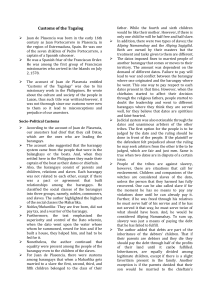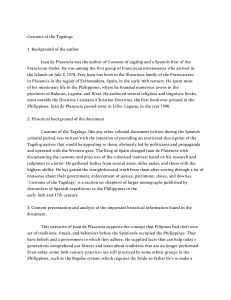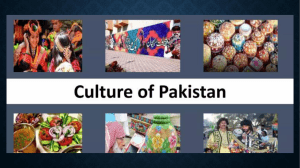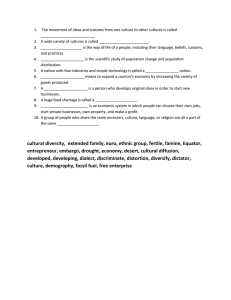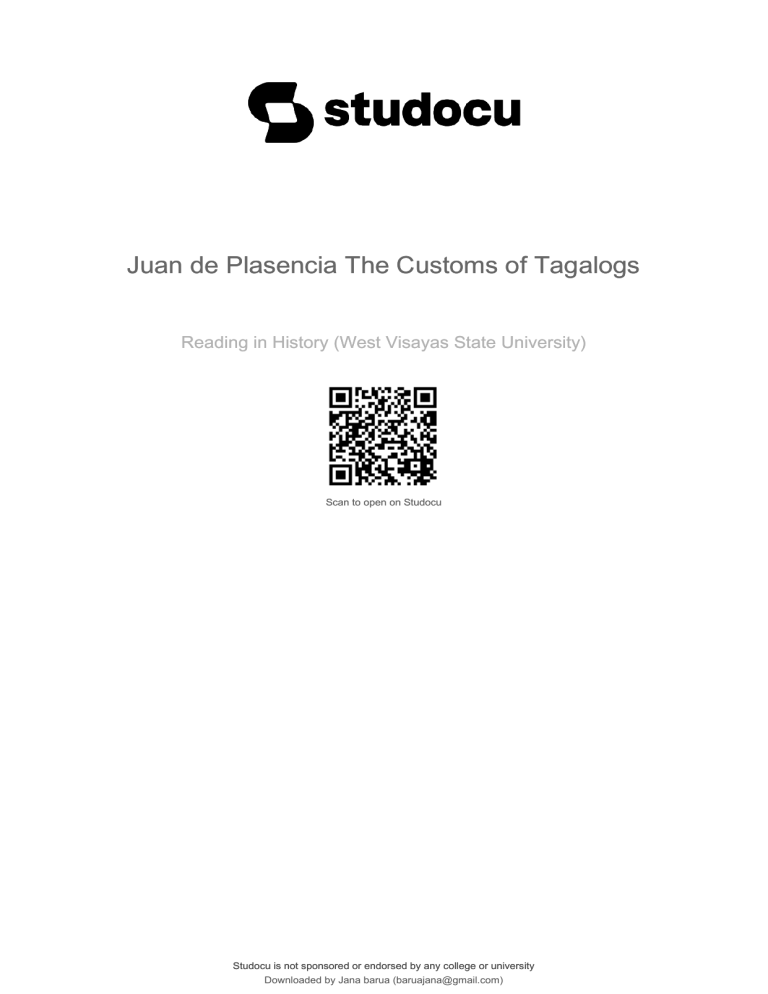
lOMoARcPSD|31513253 Juan de Plasencia The Customs of Tagalogs Reading in History (West Visayas State University) Scan to open on Studocu Studocu is not sponsored or endorsed by any college or university Downloaded by Jana barua (baruajana@gmail.com) lOMoARcPSD|31513253 Customs of the Tagalogs Juan de Plasencia was born in the early 16th century as Juan Portocarrero in Plasencia, in the region of Extremadura, Spain. He was one of the seven children of Pedro Portocarrero, a captain of a Spanish schooner. He was a Spanish friar of the Franciscan Order. He was among the first group of Franciscan missionaries who arrived in the Islands on July 2, 1578. 1. Author's background He spent most of his missionary life in the Philippines, where he founded numerous towns in Luzon and authored several religious and linguistic books, most notably the Doctrina Cristiana (Christian Doctrine), the first book ever printed in the Philippines. As soon as he arrived, he joined with another missionary, Fray Diego de Oropesa, and they both started preaching around Laguna de Bay and Tayabas, Quezon, in Quezon Province, where he founded several towns. 2. Historical background of the document In this era, during the 16th century, the Spaniards’ expeditions were very evident. With these adventures of theirs, it is a must for them to take into accounts their glorious journey. The account of Juan de Plasencia entitled “Customs of the Tagalogs” was due to his missionary work in the Philippines. He wrote about the culture and society of the people in Luzon, thus such title was written. However, it was not thorough since our customs were new to them so it lead to misconceptions and prejudice of our ancestors. His work gave descriptions of our ancestors at that time. Most of these are through our culture, which they think are exotic. This was mostly for the advantage of the Spaniards to exploit our ancestors. “Customs of the Tagalogs” is written through the eyes and hands of a Spaniard. It is not surprising how the author did not fully comprehend the socio-political status of the Luzon. It was then that barangays were the only form of governance in the Philippines. The author, Juan de Plasencia, cannot help but observe how our ancestors structure their government and how things are done in the barangays. Downloaded by Jana barua (baruajana@gmail.com) lOMoARcPSD|31513253 3. Content Analysis: Understanding the historical information. Socio-Political Customs According to the account of Juan de Plasencia, our ancestors had Identify and describe the chief that they call Datos, which are the ones who are leading the customs and traditions of barangays. the Tagalogs mentioned The account also suggested that the barangay system came from the in the document. people that were in the balanghays or the boats. And, when they settled here in the Philippines they made their captain of the boat as their datos or chieftain. Also, the barangays consist of parents and children, relations and slaves. Each barangay was not related to each other, except if there was a pact or agreement that built relationships among the barangays. He classified the social classes of the barangays into three groups, namely, nobles, commoners, and slaves. The author highlighted the highest of the social classes the Maharlika. Nobles/Maharlika- They are free born, did not pay tax, and a warrior of the barangay Furthermore, the text emphasized the superiority and control of the Dato wherein, when the dato went upon the water whose whom he summoned, rowed for him and if he built a house, they helped him, and had to be fed for it. Nonetheless, the author continued that equality were present among the people of the barangay even to the children of the slaves. For Juan de Plasencia, there were customs among barangays that when a Maharlika gets married to a slave the first, second, third, and fifth children belonged to the class of their father. While the fourth and sixth children would be like their mother. However, if there is only one child he will be half free and half slave. In addition, there were two types of slaves; the Aliping Namamahay and the Aliping Sagigilid. Both are owned by their masters but the treatment and tasks given to them are different. The datos imposed fines to married people of another barangay that comes or moves to their territory. The amount was dependent on the demand of different datos. Failure to pay will lead to war and conflict Downloaded by Jana barua (baruajana@gmail.com) lOMoARcPSD|31513253 between the barangay where one originated and the barangay where he went. This one way to pay respect to each datos present in that time. However, when the chieftains started to affect their decision through the religious fathers, people started to doubt the leadership and went to different barangays where they think they are served well, for they believe that datos are spiritless and faint-hearted. Judicial system was also noticeable through the datos and unanimous arbiters of the other tribes. The first option for the people is to be judged by the dato and the ruling should be done in front of the people. If the plaintiff or the defendant felt prejudiced about the ruling he may seek arbiters from the other tribe to be judged, which are fair and just men. Same is true when two datos are in dispute of a certain issue. People of the tribes are against slavery, however, there are situations that call for enslavement. Children and companions of the witches are considered slaves of the dato, unless the person that they harmed has fully recovered. One can be also called slave if for the moment he has no means to pay any violations done until he can already pay it. Further, if he was freed through his relatives he must serve half of his service and if he has not served it that way, he must serve twice of what should have been. And, he would be considered Aliping Namamahay. To sum up, slavery was just a means of paying the debt that he has failed to fulfill. The author added that debts are part of the inheritance of the debtors’ children. That if their parents are debtors and they die they should pay the debt through half of the profits of their land until it can be fulfilled. Inheritances, are equally divided among legitimate children, except if there is a slight favoritism present in the family. Another exception is if the parents decided that their son would be married to the chieftain’s daughter, the son would get more than any of their sons. This would be in the form of dowry. On the other hand, if one has two wives and has children to both wives, the children would divide their mother’s dowry. However, if one of his wife is a slave, she would not receive any dowry, thus, no share for her children even if they are legitimate. The children are bound to free their mother out of slavery and give her something or a slave. There are situations that the children of the slave could have the inheritance. One is if the father were a chief or it was with unanimous consent. Illegitimate children are given one-third of the inheritance. But, if one has no legitimate children, all will be given to the unmarried wife or Inaasava ‘s child. On the other hand, if Downloaded by Jana barua (baruajana@gmail.com) lOMoARcPSD|31513253 he has no children of whatsoever, this will be given to the nearest relatives. If a married woman, gave birth to a child outside of her marriage the husband can do two things: punish the wife, which was considered dowry, and the child would be considered legitimate, or disregard the wife so that the child would have nothing to inherit. With regards to adopted children, they inherit double of the payment for their adoption. If the adopted child has children and he died first, his children should not inherit it. This secures him from danger since his money is exposed and he is protected as a child. The author added that dowries are given by men to women’s parents. And, they are enjoyed by the parents if they are still living. In case of their death, it is divided among the children equally. Unless, the father stated that this additional inheritance is only for that son. If the woman has no parents, she can enjoy it together with his relatives. If the woman wants to be divorced before giving birth and seeks for another marriage, the dowry should be returned plus an additional amount to the husband. But, if she does not get married to another man, the dowry is returned. If the one who wants to be divorced is the husband only half would return to him, or if he has children to that woman all of the dowry will go to them through their grandparents or any relatives that would be responsible enough to hold it. Furthermore, other tribes practice that when the wife dies and they borne no children only half of the dowry will go to the husband. And, if the husband dies half of the dowry will be returned to his relatives. This was not generally practiced since this was through consideration and discretion of the people. Half of the dowries are given immediately to the soon-to-be-wife of the son. If they failed to do it, there are great sum of fines that they shall pay which depends on their fortune. If the woman disagrees to marry that man and she has no parents anymore, she will return the dowry. And, if her parents are still alive they would pay a fine and return the dowry to the man. These customs were observed in the natives by the friar-author. For him, these are the things that the datos regulate and if they contradict to these, they are being condemned by the people. Downloaded by Jana barua (baruajana@gmail.com) lOMoARcPSD|31513253 Religious Customs Back then, there were no temples or churches, however ceremonies and worships are celebrated in the house of the dato which they call simbahan. The house was quite big since the purpose of it is to house the people of barangay during celebrations. The sibi was constructed at the sides of the house to protect the people from the rain. The sorhile are the small lamps on the post of the house and they put a big lamp in the center of the house. Further, the worship of our ancestor is called the nagaanitos. One of the many idols that they worship is Bathala. The author believed that the name Bathala signifies “all powerful” or “maker of all things”. They also worship the sun, moon, stars (Tala ), constellations which they name Balatik and Mapulon, Dian Masantala who was patron of lovers and of the generation, Lacapati and Indianale patron of the lands and of husbandry, and crocodiles (Buaya ) which they fear from. Our ancestors are also firm believers of auguries. These can be translated into two: Good Omen and Bad Omen. They also practice divination to know if the weapon is suitable for the possessor. Years, Months, and Days are determined through observing the soil, flowers, fruits, and leaves. And, there were only two seasons present which are the sun-time and water-time. In terms of offering sacrifices, it is through festival that they offer it to the devil what they had to eat. This was done in front of an idol which they anoint with fragrance perfumes and sung poetic songs led by the priest or Catotolan. People then respond to favor them with things that they need. Some idols are covered in a cloth twice so that they could worship the devil without seeing the idol. Also, the devil could possess the priest that his eyes would shoot flames, have a fearful sight to those beholding, and uttered words of arrogance. In some places, when one is possessed by the devil he will be tied to a tree, to prevent the devil from destroying him. Most of the offerings are swine, goats, and fowls which are decapitated in front of the idol. As Downloaded by Jana barua (baruajana@gmail.com) lOMoARcPSD|31513253 part of the ceremony they break a jar that contains cooked rice which was also set in front of the idol. After that these offerings are eaten by the guest of the feast. They offer sacrifices for several reasons these are the recovery of a sick person, the prosperous voyage of those embarking on the sea, a good harvest in the sowed lands, a propitious result in wars, a successful delivery in childbirth, and a happy outcome in married life. If this is celebrated by people with ranks in the barangay it would last 30 days. With regards to the monthly period of girls, their eyes are covered for four days and four nights. At the end of the period, the priest would take the girl to the river and bath her. This should bless the girl to bear a child and have successful marriage. In the religious customs of our natives they have distinguish 12 kinds of devils priest: Catolonan - was either a man or a woman. This office was an honorable one among the natives, and was held ordinarily by the people of rank, this rule being general in all the islands. Mangangauay- wishes who deceived by pretending to heal the sick. These priests even induced maladies by their charms, which in proportion to the strength and efficacy of the witchcraft, are capable of causing death. Manyisalat- These priests had the power of applying such remedies to lovers that they would abandoned and despise their own wives, and in fact could prevent them from having intercourse with the latter. Mancocolam- whose duty was to emit fire from himself at night, once a month. Hocloban- Without the use of medicine, and by simply saluting or raising the hand, they killed whom they chose. But if they desired to heal those whom they had made ill by their charms, they did so by using other charms. Silagan- whose office it was if they saw anyone clothed in white, to tear out its liver and eat it, thus causing his death. Magtatangal- his purpose was to show himself at night to many persons, without his head or entrails. In such wise the devil walled about carried, or pretended to carry, his head to different places: and, Downloaded by Jana barua (baruajana@gmail.com) lOMoARcPSD|31513253 in the morning, returned it to his body remaining, as before, alive. Osuang- equivalent to sorcerer, they say that they have seen him fly, and that he murdered men and ate their flesh. Mangagayoma- They made charms for lovers out of herbs, stones, and wood which would infuse the heart with love. Sonat- which is equivalent to preacher. It was his office to help one to die, at which time he predicted the salvation or condemnation of the soul. It was not lawful for the functions of this office to be fulfilled by others than the people of high standing, on account of the esteem in which it was held. Pangatahojan-was a soothsayer, and predicted the future. Bayoguin- signified a cotoquean a man whose nature inclined toward that of a woman. The author also stated how our ancestors buried the dead. The dead was buried beside his house, or if he is a chief his body would be beneath a little house which they constructed. They will mourn for 4 days and afterward, laid him on a boat which served as a coffin or bier, placing him beneath the porch, where guard was kept over him by salve. In place of rowers, various animals were placed two male and female of each species. The slaves would take care of the animals which they should make sure that it was well fed. If the dead is a warrior, the slave would be tied to his body until it wretched the way he died. They would sing praises for the deceased for his good qualities, they also accompany this with drinking and eating. Negritos, however, do not believe in these customs. They are convinced that there is another life of rest or what they call MACA. They believed that only people that didn’t do harm would go there and if he possessed moral virtues. There is also a place called CASANAAN on the other life which was the place of anguish. According to Negritos, souls in casanaan will face the demon that they call SITAN. As what I have stated in the historical background of the document, this account was in favor of the Spaniards since they use these What are the factors that accounts as their propaganda and for their benefit. It is well-known that the author is a friar from Spain which could justify the previous could have influenced statement. However, this does not suggest that the whole content is 4. Contextual Analysis: Downloaded by Jana barua (baruajana@gmail.com) lOMoARcPSD|31513253 based on false accounts. In fairness, the author wrote the contents of Juan de Plasencia in the this account from his experiences throughout his journey in Luzon. He writing of the document? has lived in the Philippines for 10-20 years which could be fair to Explain. write this account. Moving on, the Philippines at that time was just a nation and there was no formal government present. Also, the only informal government that was present was the barangay which came from the people of the balanghays. Juan de Plasencia, in his accounts, based the pre-colonial government of the Philippines on customs and practices. Most of the customs were regarding inheritances and marriages. Also, during that time judicial system was also informal. The author observed that datos and some respected men served as judges of disputes. It was evident that datos have most of the control in the barangay which makes him the head of the tribe. In this, the author stated that villages or barangays were not related to each other. It means that there was a gap between them and separates on from the other. This would show the pride and glory of each since alliances were not a thing yet unless there was an agreement and pacts that bound both villages. Slaves were also present at that because of their debts and not because there were any prejudice. This is because our ancestors were against slavery but it was used for payments of the credits that some can’t pay. Marriages also played a vital role in the society, since the wife and husband were bound to the village where they live. Also, marriage and divorce will dictate the inheritances of their children. Relationships among maharlika, commoners, and slaves were also evident that time since the author observed rules with regards to the marriage of a slave and a free man. There were also rules that involve the inheritance and/or the dowry of a deceased man or woman. Of course, our ancestors also have provisions about adultery and failed marriages. The society also gave importance to the fiancée of any man. Dowries were also a tradition back then. The dowry serves as a promise and an appreciation to the family of the woman. Since custom encompasses the religious practices of the people, the author has pointed out some of it. Religious practices of our ancestors Downloaded by Jana barua (baruajana@gmail.com) lOMoARcPSD|31513253 are exotic for them. It is because Juan de Plasencia is a catholic and it is very different with their beliefs. There were terms in the religious aspect of the natives that were new to them. The native people according to the friar were worshipping many idols and that they also worship nature. It suggests that our ancestors’ religion was animism. They pray to the nature like the sun, moon, or even trees, basically, anything that they think affects their lives. When they have special request or when they just want to worship, they celebrate it through a feast. During the feast they offer animals or products that they have harvested. For them, the offerings will be appreciated by the one who they have worshipped. They had also various gods to represent different aspects of life. However, the god that they ultimately worshipped was Bathala, who, for them, is the maker of life. There was no system of organizing the days at that time. So, our ancestors incorporate the season through the soil and their harvest. The natives have different kind of priests, which are devil according to friar. Each of them has various functions and roles in the society. However, most of it were condemned by the people and there were few that the people accepted. 5. What is the relevance / contribution of the document in Philippine history? “Customs of the Tagalogs” contributes to two different times. First, during the time when colonizers did not know about the Philippines. Second, is for the present time to understand how the pre-colonial cultures started and developed. The account exposes the untouched culture of the people of Luzon to the whole world. This account journalizes how the socio-political status and religious customs were, before the Spaniards would influence it. It tells us how the social structure started and it came from. It also shows how relationships, especially marriages, are given importance. The account also indicates the importance and roles of the chieftain or datos. These would give a huge benefit for the Spaniards, since they saw how our ancestors’ culture works and they could think ways on how to influence the people of Luzon. The book is a collection of observations of the society of the people of Luzon from the eyes of an outsider. This would make us aware of Downloaded by Jana barua (baruajana@gmail.com) lOMoARcPSD|31513253 the cultures we had before the colonizers controlled our ancestors’ customs and practices. Furthermore, the book lets us appreciate how our ancestors developed this structure and we could be hypothetical of the result if the Spaniards did not colonize the Philippines. The author argues that the Philippines has a rich culture, however, the natives’ culture were completely different from theirs. In his accounts, he writes customs that were new to him. In addition to this, he uses adjectives that would look the culture of the Tagalogs as exotic to the world. He suggests the differences of the culture present compared to the western culture. 6. What are the author's main arguments? Moreover, he tells to the world that the Philippines has their own culture even before they have arrived. There were unwritten rules in the society that was followed to secure peace and order in the villages. Further, he states how people treat relationships and properties with regards to the unwritten rules of the society. In addition, he tells to the world how religious beliefs in Luzon are. He recognizes gods of the people which are non-existent to them. Also, the author demonstrates how the people perform their worship differently and distinguishes kinds of priest present at that time. He ended his account with a wish that this customs and beliefs would be forgotten and that Catholicism should prevail in this society. The last statement shows his disgust to these practice and desires that Luzon should worship God and have faith on the bible. The books “Customs of Tagalogs” written by the friar-author, Juan de 7. Your own overall observation and insights Plasencia, pertains particularly to the socio-political and religious practices of the people from Luzon around 16th century. The account on the primary source focused on practices that seemed strange to the Spaniards. The author also compared some of the practices and beliefs to other culture like of the romans, which for me is unjust when one culture is just new to you. The book was all about from the context of the people of the Luzon which the author could somehow misinterpret it. Further, there were no interviews written in the account but just instances and events at that time. It would be better if the customs and practices would come directly from a prominent or a high rank person of the tribe. With that, the account would be reliable and valid for the future generation to read. Also, there was texts that was bias for the Spaniards. Example is how the author ended the account, it showed his disgust and subjectivity of the practices and beliefs of the Filipinos. On the other hand, the author gave us a glimpse of how the people of Downloaded by Jana barua (baruajana@gmail.com) lOMoARcPSD|31513253 Luzon act within the society and how villages relate with each other. Even if it was not thorough, Juan de Plasencia presented the instances of the people at that time, which can help us to understand how and what we were during the 16th century. It was just a little disturbing with regards to his approach and on how he showed to the rest of the world how Filipino culture is Downloaded by Jana barua (baruajana@gmail.com)
